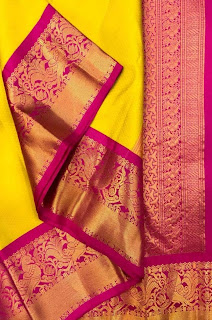TRADITIONAL SAREES FROM MAHARASHTRA : TYPE,DESIGN AND LOOK WITH IMAGES
Traditional
sarees from Maharashtra own the beauty and uniqueness with richness and grace.
The draping style in Maharashtra is different, and it even enhances the overall
elegance quotient. Traditional Maharashtrian sarees are Maharashtra's cultural heritage.
The sarees from Maharashtra are exquisite handloom sarees.
The
types of sarees from Maharashtra that look absolutely gorgeous-
Paithani Saree
Paithani is considered as one of the
traditional royal sarees, not only among the women of Maharashtra but among the
women across India. Paithani
saree is a trademark of Indian tradition and honour. The art of Paithani
is over 2000 years old, was developed in the Satvahan dynasty (the then
Pratishthan Nagar). This is named after the Paithan town
in Aurangabad, Maharashtra
where the saree was first handmade. Present day Yeola town in Nashik, Maharashtra is the largest
manufacturer of traditional Paithani saree. Paithani is made with silk and
Zari in Fly shuttle and pit loom. The structure of the horizontal quadrangle of
Zari is the uniqueness of the traditional Paithani Saree and Asavali, Peacock,
Lotus, and Mango traditional design as well as small motifs are available on
Paithani. Single colored and kaleidoscope-colored
designs are also popular on Paithani. The kaleidoscopic effect is achieved by
using one color for weaving lengthwise and another for weaving width wise. Paithani
is a three-generation pioneer and women are still using traditional Paithani during
social and religious work and in wedding ceremony.

Kolhapuri
Saree
Kolhapuri
saree is one of the native traditional sarees of Maharashtra. The elegant and classy Kolhapuri sarees are carefully
woven in Kolhapur, Maharashtra. Kolhapuri Sarees
are used to make in pure cotton or pure silk and come in different
vibrant colours. The zari embroidery bordering the saree, is intricately woven,
and these traditional sarees are worn during weddings or festivals to look
regal.
Himroo
Saree
This
traditional handloom saree has historically been produced in Aurangabad,
Maharashtra. The materials used for this sarees are cotton and pure silk. The Geometrical
and floral patterns along with intricate creeper design. Himroo is a type of
extra-weft manufactured ordinarily in throw suttle from cotton and viscose
rayon yarn on a cotton ground. It is also woven from silk yarn and gold thread
on a silk ground giving it a satin-like look. In olden days, traditional Himroo
saree was worn by the ladies of the royal household.
Khana Saree
Khana
saree originated in the regions of South Maharashtra. Materials used to make
this traditional saree are pure silk, art silk (viscose blend), and pure
cotton. Khana material is a historically and culturally significant fabric in
Maharashtra. It might have been started in the 8th century CE when the Chalukya
Dynasty was in power in this region. It is made with extra warp dobby figures
and is always produced by keeping definite width and length in pit loom. On
this traditional saree, geometrical designs are seen that look like honeycomb
or floral patterns along with creepers, fruits, and seeds. It is a tradition to
offer a Khana saree extensively to the God, always folded in a typical
triangular shape.
Hand Block
Print Saree
Hand
block printing is extensively done in the Vidarbha area of Maharashtra. The
artisans engaged in this craft are called “Bavasars” community, the
practitioners of this craft mainly use natural colors. The Traditional sarees
are hand-woven silk or mill-made chiffon cloth on which block oriented painting
of floral and animal designs are done with delicately carved wooden and brass
blocks. The results are multi-colour designs in traditional patterns. The 'Tree
of Life' motif is very widely used in this saree



















You can visit our new site Solapuri Saree
ReplyDelete, Khana Saree,banarasi saree and many more.
for traditional Indian wedding.
I like this nauvari style of saree draping, My sister tried it many times but it is tough to drape like this.
ReplyDeletehttps://directdilsebycookie.blogspot.com/
apne products
ReplyDeleteAwesome article,
ReplyDeleteReally happy by reading this article - please also visit my blog I post a great content
https://directdilsebycookie.blogspot.com
Mother's Love-Mental Peace, Love & Support
Hindi Poetry, English Poetry, Writing, Quotes
Everyone needs Love & Support in life, it encourages and motivates, it keeps you enthuziastic
Really i appreciate your hard work and amzing priceless information provided by you. One of the most important blog i read continiously.
ReplyDeleteShopclues lucky coupons 2020
I like your wonderful designs .
ReplyDeleteOpen Demat Account
Great info
ReplyDeleteThe blogs you write include the words that have deep meanings. The worth of your words is the knowledge that you pore your writings. Keep it up and I shall come again to read your magical words.
ReplyDeletevery cheap clothes uk
Great post. Thanks for sharing.
ReplyDeleteClick here to know more Handloom Sarees in Bhubaneswar
Great post. Thanks for sharing.
ReplyDeleteClick here to know more "Buy Handloom cotton saree in Bhubaneswar | Reemlydesignstudio"